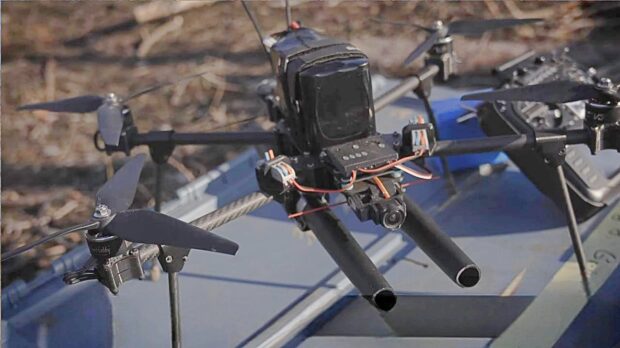A Ukrainian Presidential Brigade has begun using FPV drones equipped with a double-barreled shotgun to intercept Russian Mavic drones.
According to the brigade, the technical innovation was introduced by engineers of the 4th Mechanized Battalion. It allows it to effectively intercept enemy drones over the contact line.
The commander of the 4th Mechanized Battalion’s UAV platoon, call sign “Compass,” stated that this tool is crucial, as the biggest threat to infantry on the front line is not FPV drones, but quadcopters carrying munitions.
To create the interceptor drone, the military adapted the LUCKY STRIKE FPV bomber and installed two guns specially designed for this task.
According to the video, the design of the guns provides recoil compensation, which increases the accuracy of the drone’s shooting.According to the commander of the “Filin” unit, there is nothing complicated about flying such a drone, but you need to have a good reaction and know when to shoot.
The video shows the shotgun drone in close-up detail. The operator loads a shotgun cartridge into a short tube and clips it into place. This is standard shotgun ammunition, which one commenter identifies as 12-gauge number 4 buckshot with a load of around 25 pellets of .13″ diameter. Other details are less obvious.
Small arms historian Matthew Moss carried out an analysis of one Russian project on his site The Amourer’s Bench. This launched a counterweight backward at the same time as the projectile is fired forward, a technique which Moss dates back to the 1910s and the recoilless guns developed by Commander Cleland Davis of the U.S. Navy.
“They’re careful not to show too much, but they do show it’s electrically ignited,” Moss told me. “Looks like they have removed the original primer from the cartridge.”
The shotgun tube is supported by a single clip, and there are four clips in all. A closer look shows two pairs of tubes mounted back-to-back.
“You can see that there’s a charge that fires to the rear,” says Moss.
In theory using two cartridges firing in opposite directions should completely cancel out recoil, if the loads are exactly the same.
“The lack of recoil is likely a combination of the use of another identical cartridge as a counterweight charge and the gun system being mounted on a fairly powerful, sophisticated drone,” says Moss.
A backward-and-forward firing shotgun would be extremely dangerous in other situations. But for a weapon fired from a drone, it provides what Moss calls a “simple and elegant” solution to a challenging problem.
The lack of recoil means that if the operator misses with the first shot, or if the target is only damaged, they can rapidly aim again with the second barrel. And high in the air, random shot fired backwards should not be an issue.
In the video the shotgun drone fires at a paper target from a range of about 15 feet and appears to be accurate with a fairly dense pattern of shot. One pellet should be enough to bring down a drone. There is practically no visible recoil.
Sources: Forbes; MILITARNYI


